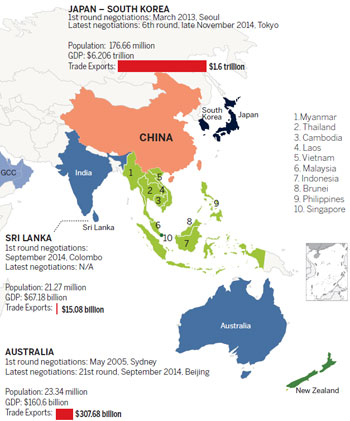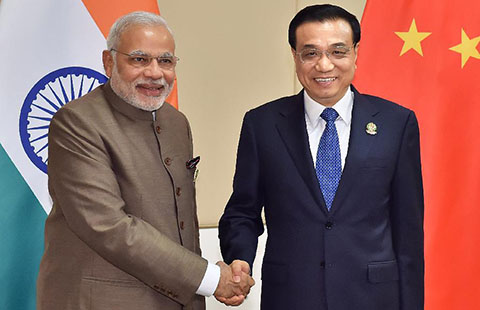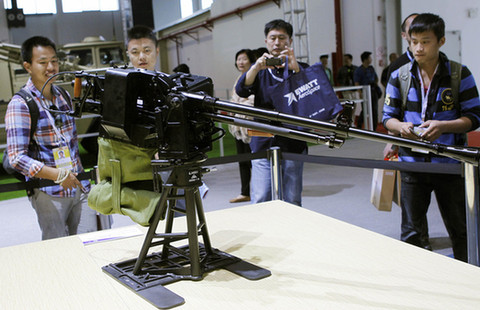China, ASEAN set 2015 as goal for upgrading free trade agreement
Updated: 2014-11-14 05:03
By ZHAO YINAN in Nay Pyi Taw and ZHONG NAN in Beijing(China Daily)
|
||||||||
Move aims to provide frameworks for achieving a new level of economic integration
China and the Association of Southeast Asian Nations members have set a goal to conclude the negotiations on upgrading the China-ASEAN Free Trade Area by the end of 2015, as both sides are keen to pursue a larger foothold in each other's lucrative markets with more access to foreign goods and investment.

Premier Li Keqiang said China is willing to take part in the CAFTA negotiations on the basis of the pre-establishment of national treatment plus the negative list model, as well as supporting Hong Kong further in talks on building a free trade area with ASEAN countries.
"China will set aside 30 million yuan ($4.9 million) over the next three years to support economic and technical cooperation between the two sides," Li said on Thursday at the 17th China-ASEAN Leaders' Meeting, in Nay Pyi Taw, the capital of Myanmar.
The two sides launched their first round of negotiations on upgrading CAFTA in September, and agreed to focus on key areas of trade in goods, service trade, dispute settlement and investment.
Launched in 2010, CAFTA has become the world's largest free trade area among developing countries, with a population of 1.9 billion.
"In our view, various FTA arrangements need to play a positive role in fostering a just and free international and regional trade order," said Li.
While accelerating CAFTA negotiations, China has contributed to Regional Comprehensive Economic Partnership negotiations, which have moved from consultations on procedures to a new stage of substantive negotiations.
Moreover, parties attending the just-concluded APEC Economic Leaders' Meeting in Beijing all supported starting talks on establishing a Free Trade Area of the Asia-Pacific. China is also open to negotiations on the Trans-Pacific Partnership.
Li said China will encourage its companies to invest in the ASEAN member markets, as well as cooperating with local partners to build cross-border businesses and industrial zones to accelerate the pace of regional economic integration.
China is ASEAN's largest trading partner, while ASEAN ranks as China's third-largest trading partner. Bilateral trade increased 11 percent year-on-year to $443.61 billion in 2013.
In the first three quarters of this year, the trade figure reached $346.6 billion, a 7.5 percent year-on-year increase. Both sides are also determined to push their trade volume to $500 billion by 2015 and $1 trillion by 2020.
Wang Zhile, a senior researcher at the Chinese Academy of International Trade and Economic Cooperation said as countries differ in their economic development modes, pillar industries and political environments, China is taking a flexible stance in negotiations to upgrade CAFTA and allow special treatment for the least developed ASEAN countries.
Eager to build up a solid cooperative foundation, the two sides have implemented a large number of projects in power generation, bridge-building, agriculture and manufacturing during the past decade.
China has set up the China-ASEAN Investment Cooperation Fund to provide the ASEAN with preferential financing support, which has promoted the economic development of ASEAN countries and benefited local peoples.
"The new cooperative development between China and ASEAN members is not only or mainly about broadening trade liberalization, but also about building frameworks for efficient regulatory cooperation and investment in infrastructure, industrial and social development to facilitate economic integration at a new level with more real actions, creative ideas and methods," said Wang.
Contact the writer at zhaoyinan@chinadaily.com.cn
- China pledges $480m aid to ASEAN
- Upgraded version of ASEAN-China FTA
- China, ASEAN identify dual-track approach for dealing with South China Sea issue: Li
- ASEAN leaders pledge to announce national targets before key climate talks
- China, ASEAN discuss concluding treaty
- UN calls for ASEAN support on post-2015 development
- HK to play unique role in advancing China-ASEAN cooperation
- China, ASEAN embarking on cooperation of 'diamond decade'
- Li's Myanmar tour to open new chapter in China-ASEAN ties
- Growing relationship between China and ASEAN highlighted
- 4 terrorists allegedly have infiltrated into Myanmar before ASEAN summit
- Vietnam to host series of ASEAN army meetings
- China, ASEAN to accelerate upgraded FTA negotiations
- Li to push for closer links with ASEAN countries
- China, ASEAN to accelerate upgraded FTA negotiations
- S. Korea to hold drill in islets disputed with Japan: Seoul
- China, Pakistan pledge to strengthen air force cooperation
- B20 urges G20 to make bold commitments for growth, jobs
- Britain to introduce tough new foreign fighter laws
- World's tallest man meets world's shortest man
- Lang Lang honored with German award

 Premier Li pledges to strengthen cooperation with India
Premier Li pledges to strengthen cooperation with India
 Lang Lang honored with German award
Lang Lang honored with German award
 Airshow China soars to success in Zhuhai
Airshow China soars to success in Zhuhai
 The most people dine on the beds
The most people dine on the beds
 Dangling workers rescued from World Trade Center
Dangling workers rescued from World Trade Center
 Long-term visas issued for China, US citizens
Long-term visas issued for China, US citizens
 Long-term visas issued for China, US citizens
Long-term visas issued for China, US citizens
 Culture Insider: Chic items in ancient China
Culture Insider: Chic items in ancient China
Most Viewed
Editor's Picks

|

|

|

|

|

|
Today's Top News
US spying scheme targets Americans' cellphones
The Waldorf's hefty price tag
China, US to build milk-powder plant in Kansas
China, ASEAN set goal for upgrading FTA
Country pushes for code at South China Sea
Beijing wants to keep 'APEC blue'
US, China reach landmark pacts
Youth urged to get politically involved
US Weekly

|

|








